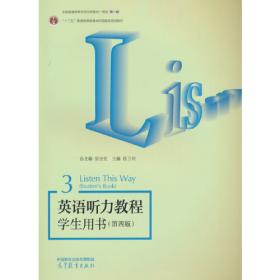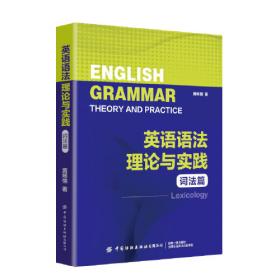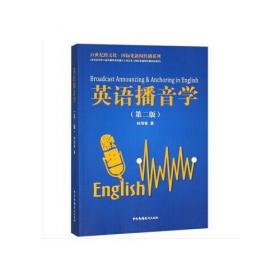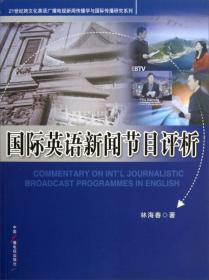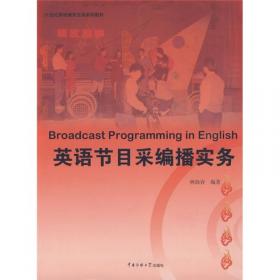英语辩论基础/21世纪非母语对外传播暨英语播音主持与国际化新闻传播系列
出版时间:
2016-12
版次:
1
ISBN:
9787504377975
定价:
72.00
装帧:
平装
开本:
16开
纸张:
胶版纸
页数:
499页
字数:
215千字
正文语种:
简体中文,英语
23人买过
-
《英语辩论基础/21世纪非母语对外传播暨英语播音主持与国际化新闻传播系列》是目前在中国大陆范围内首次出版的,有关运用非母语英语驾驭“英语辩论”三种基本风格的书籍。它是笔者对执教了多年的《英语辩论》课之经验的总结,是对在辅导辩手参加了多届中国大陆目前具规模、具影响力的“全国英语辩论赛”的实战思考的提炼。编者主要讲解了三种主要的英语辩论风格,即,“ValueDebating”、“ParliamentaryDebating”和“Cross-examination Debating”。由于建构“辩论”的理论和规则是由“西方”完成的,所以,为了适合中国学生的思维方式,是为了激发中国学生的“批判式思维”,《英语辩论基础/21世纪非母语对外传播暨英语播音主持与国际化新闻传播系列》作者试图以理论介绍为出发点,以所执教的学生在《英语辩论》课上的实训为个案分析,从而,使得较为抽象和西化的理论变得较易理解。 林海春,瑞典马尔默大学研究员,瑞典隆德大学博士,现任中国传媒大学“英播播音与主持”教研主任。 1.Background背景
1.1 Definition定义
1.I.1 What Is Debate?
1.2 Key Questions关键问题
1.2.1 What Does“Debating”Mean?
1.2.2 How Does Debating Work?
(“Parliamentary Debating”as a case)
1.2.3 How Did Debating Start?
1.3 Case:Original Background of Parliamentary Debate初始背景
1.3.1 PD in Westem System
1.3.2 BP of PD for Tournament
1.3.3 Debating for Western Mental Orientation
1.4 Aim ofthe Course课程目的
1.4.1 General Information
1.4.2 Why Is This Course?
1.4.3 Aim ofthe Course
Part Ⅰ Value Debating价值辩论
2.Basic Terms and Debating Skills基本术语及辩论技巧
2.1 Concepts概念
2.1.1 What Is a Motion?[Debating Topic]
2.1.2 Definition OfContents ofMotion
2.1.3 Team-line tO Hold
2.1.4 The Rebuttal
2.1.5 3M.Matter Method Manner
2.2 Basic Rules:The Roles of the Debaters基本条件:辩手之角色
2.3 Case.studies(Value Debating)案例研究
Part Ⅱ Parliamentary Debating议会制辩论
3.Background of Parliamentary Debate议会建制背景
3.1 Parliamentary system议会制
3.1.1 Background and Advantages of a parliamentary system
3.1.2 Criticisms of Parliamentarianism
3.1.3 Countries with a parliamentary system of government
3.1.4 Parliamentary Leader
3.2 Background of Debating Chamber辩论议事厅的背景
3.3 Key Questions关键问题
3.4 The GuidetoAmericanParliamentaryDebate“美式议会制辩论”导读
3.4.1 Overview ofAmerican Parliamentary Debate
3.4.2 The debaters and the speeches
3.5 Guidelines and Conventions about American Parliamentary Debate“美式议会制辩论”指南及条例
3.5.1 American Parliamentary Debate is a formal contest featuring critical analysis,rhetorical skill,and wit
3.5.2 A resolution is presented as the subject for debate
3.5.3 Two types offormal speeches in each round ofdebate
3.5.4 The purpose of constructive speeches is to introduce the foundational arguments ofthe debate
3.5.5 The rebuttal speeches provide the final summary positions of each team in the debate
3.5.6 Modified form ofparliamentary procedure is used in the debate
3.5.7 No prepared materials may be brought into the debate round for the debater’S use
3.5.8 Sample topics
3.6 On Parliamentary Debate ofAmerican Style试析“美式议会制辩论”
3.6.1 The Nature of Parliamentary Debate
3.6.2 Focus on Extemporaneous Debate
3.6.3 Focus on Informed Debate
3.6.4 Focus on Reasoned Debate
3.6.5 Focus on Public Debate
3.6.6 The American Parliamentary Debate Format
3.7 American Parliamentary Debate美式议会制辩论
3.8 Study-case-1:Training Session of American Parliamentary Debate
学习个案-1: “美式议会制辩论”训练环节
3.9 British Parliamentary Debate英式议会制辩论
3.9.1 The political system in the UK
3.9.2 An Introduction to British Parliamentary Debate
3.9.3 Four—Team Parliamentary Debate Rules
3.9.4 Study—cases—2:Training Session ofBritish Parliamentary
Debate学习个案—2: “英式议会制辩论”训练
Part Ⅲ Cross-Examination Debating盘问式辩论
4.1 Why Is Cross-examination Important?为什么盘问重要?
4.2 Why Do We Conduct Cross—examination?为什么我们进行盘问?
4.3 What Are the Goals of Cross.examination?盘问的目标是什么?
4.4 How should the questioner conduct cross—examination?提问者如何驾驭盘问?
4.4.1 Adopt a Formal Stance
4.4.2 Prioritize Your Questions
4.4.3 Don’t Make Speeches
4.4.4 Anticipate the Answer
4.4.5 Group Your Questions
4.4.6 Be Fair.
4.4.7 Control the Time
4.4.8 Control Your Style
4.4.9 Use What You Elicit
4.5 Can We Understand an Example of Cross—examination?
你能理解盘问的一个例子吗?
4.6 How Should the Witness Act During Cross—examination?
在盘问过程中目击者如何表现?
4.6.1 Adopt a Formal Stance
4.6.2 Be Direct
4.6.3 Be Honest
4.6.4 Answer,Don’t Ask
4.6.7 Think Ahead
4.6.8 Remain Poised
4.7 What Is the Most Common Cross.examination Question?
什么是最普遍的盘问问题?
4.8 Rules of Cross.Examination Debate“盘问式辩论”的规则
4.9 Training Case of Cross—examination Debate
“盘问式辩论”训练案例
Conclusion总结
Appendices附录
Appendix-1:国际英语辩论界对世界级别的赛事规则的介绍
Appendix-2:参加“全国英语辩论赛”的选手之参赛体会和收获
Appendix-3:在《英语辩论》课设计的实训里,经过历练和锤打后的参与者们获得的认识与感悟
References参考文献
结束语
-
内容简介:
《英语辩论基础/21世纪非母语对外传播暨英语播音主持与国际化新闻传播系列》是目前在中国大陆范围内首次出版的,有关运用非母语英语驾驭“英语辩论”三种基本风格的书籍。它是笔者对执教了多年的《英语辩论》课之经验的总结,是对在辅导辩手参加了多届中国大陆目前具规模、具影响力的“全国英语辩论赛”的实战思考的提炼。编者主要讲解了三种主要的英语辩论风格,即,“ValueDebating”、“ParliamentaryDebating”和“Cross-examination Debating”。由于建构“辩论”的理论和规则是由“西方”完成的,所以,为了适合中国学生的思维方式,是为了激发中国学生的“批判式思维”,《英语辩论基础/21世纪非母语对外传播暨英语播音主持与国际化新闻传播系列》作者试图以理论介绍为出发点,以所执教的学生在《英语辩论》课上的实训为个案分析,从而,使得较为抽象和西化的理论变得较易理解。
-
作者简介:
林海春,瑞典马尔默大学研究员,瑞典隆德大学博士,现任中国传媒大学“英播播音与主持”教研主任。
-
目录:
1.Background背景
1.1 Definition定义
1.I.1 What Is Debate?
1.2 Key Questions关键问题
1.2.1 What Does“Debating”Mean?
1.2.2 How Does Debating Work?
(“Parliamentary Debating”as a case)
1.2.3 How Did Debating Start?
1.3 Case:Original Background of Parliamentary Debate初始背景
1.3.1 PD in Westem System
1.3.2 BP of PD for Tournament
1.3.3 Debating for Western Mental Orientation
1.4 Aim ofthe Course课程目的
1.4.1 General Information
1.4.2 Why Is This Course?
1.4.3 Aim ofthe Course
Part Ⅰ Value Debating价值辩论
2.Basic Terms and Debating Skills基本术语及辩论技巧
2.1 Concepts概念
2.1.1 What Is a Motion?[Debating Topic]
2.1.2 Definition OfContents ofMotion
2.1.3 Team-line tO Hold
2.1.4 The Rebuttal
2.1.5 3M.Matter Method Manner
2.2 Basic Rules:The Roles of the Debaters基本条件:辩手之角色
2.3 Case.studies(Value Debating)案例研究
Part Ⅱ Parliamentary Debating议会制辩论
3.Background of Parliamentary Debate议会建制背景
3.1 Parliamentary system议会制
3.1.1 Background and Advantages of a parliamentary system
3.1.2 Criticisms of Parliamentarianism
3.1.3 Countries with a parliamentary system of government
3.1.4 Parliamentary Leader
3.2 Background of Debating Chamber辩论议事厅的背景
3.3 Key Questions关键问题
3.4 The GuidetoAmericanParliamentaryDebate“美式议会制辩论”导读
3.4.1 Overview ofAmerican Parliamentary Debate
3.4.2 The debaters and the speeches
3.5 Guidelines and Conventions about American Parliamentary Debate“美式议会制辩论”指南及条例
3.5.1 American Parliamentary Debate is a formal contest featuring critical analysis,rhetorical skill,and wit
3.5.2 A resolution is presented as the subject for debate
3.5.3 Two types offormal speeches in each round ofdebate
3.5.4 The purpose of constructive speeches is to introduce the foundational arguments ofthe debate
3.5.5 The rebuttal speeches provide the final summary positions of each team in the debate
3.5.6 Modified form ofparliamentary procedure is used in the debate
3.5.7 No prepared materials may be brought into the debate round for the debater’S use
3.5.8 Sample topics
3.6 On Parliamentary Debate ofAmerican Style试析“美式议会制辩论”
3.6.1 The Nature of Parliamentary Debate
3.6.2 Focus on Extemporaneous Debate
3.6.3 Focus on Informed Debate
3.6.4 Focus on Reasoned Debate
3.6.5 Focus on Public Debate
3.6.6 The American Parliamentary Debate Format
3.7 American Parliamentary Debate美式议会制辩论
3.8 Study-case-1:Training Session of American Parliamentary Debate
学习个案-1: “美式议会制辩论”训练环节
3.9 British Parliamentary Debate英式议会制辩论
3.9.1 The political system in the UK
3.9.2 An Introduction to British Parliamentary Debate
3.9.3 Four—Team Parliamentary Debate Rules
3.9.4 Study—cases—2:Training Session ofBritish Parliamentary
Debate学习个案—2: “英式议会制辩论”训练
Part Ⅲ Cross-Examination Debating盘问式辩论
4.1 Why Is Cross-examination Important?为什么盘问重要?
4.2 Why Do We Conduct Cross—examination?为什么我们进行盘问?
4.3 What Are the Goals of Cross.examination?盘问的目标是什么?
4.4 How should the questioner conduct cross—examination?提问者如何驾驭盘问?
4.4.1 Adopt a Formal Stance
4.4.2 Prioritize Your Questions
4.4.3 Don’t Make Speeches
4.4.4 Anticipate the Answer
4.4.5 Group Your Questions
4.4.6 Be Fair.
4.4.7 Control the Time
4.4.8 Control Your Style
4.4.9 Use What You Elicit
4.5 Can We Understand an Example of Cross—examination?
你能理解盘问的一个例子吗?
4.6 How Should the Witness Act During Cross—examination?
在盘问过程中目击者如何表现?
4.6.1 Adopt a Formal Stance
4.6.2 Be Direct
4.6.3 Be Honest
4.6.4 Answer,Don’t Ask
4.6.7 Think Ahead
4.6.8 Remain Poised
4.7 What Is the Most Common Cross.examination Question?
什么是最普遍的盘问问题?
4.8 Rules of Cross.Examination Debate“盘问式辩论”的规则
4.9 Training Case of Cross—examination Debate
“盘问式辩论”训练案例
Conclusion总结
Appendices附录
Appendix-1:国际英语辩论界对世界级别的赛事规则的介绍
Appendix-2:参加“全国英语辩论赛”的选手之参赛体会和收获
Appendix-3:在《英语辩论》课设计的实训里,经过历练和锤打后的参与者们获得的认识与感悟
References参考文献
结束语
查看详情
-
全新
河北省保定市
平均发货31小时
成功完成率88.69%
-
全新
江苏省南京市
平均发货6小时
成功完成率96.35%
-
全新
北京市朝阳区
平均发货32小时
成功完成率83.9%
-
全新
江苏省无锡市
平均发货14小时
成功完成率95.03%
-
全新
天津市西青区
平均发货15小时
成功完成率91.08%
-
全新
-
全新
广东省广州市
平均发货7小时
成功完成率93.89%
-
 5
5
全新
北京市丰台区
平均发货29小时
成功完成率85.96%
-
全新
浙江省嘉兴市
平均发货13小时
成功完成率94.97%
-
八五品
山东省枣庄市
平均发货9小时
成功完成率88.03%
-
全新
四川省成都市
平均发货16小时
成功完成率90.07%
-
八五品
山东省枣庄市
平均发货8小时
成功完成率88.93%
-
全新
河北省保定市
平均发货22小时
成功完成率81.4%
-
全新
河北省保定市
平均发货27小时
成功完成率84.09%
-
九品
北京市海淀区
平均发货23小时
成功完成率89.8%
-
九品
北京市东城区
平均发货25小时
成功完成率89.14%
-
八五品
山东省济南市
平均发货8小时
成功完成率94.22%
-
全新
北京市房山区
平均发货35小时
成功完成率83.1%
-
全新
广东省广州市
平均发货17小时
成功完成率94.84%
-
2024-03 印刷
印次: 1
全新
北京市朝阳区
平均发货13小时
成功完成率85.49%
-
全新
广东省广州市
平均发货17小时
成功完成率93.38%
-
全新
江苏省南京市
平均发货5小时
成功完成率98.12%
-
全新
四川省成都市
平均发货7小时
成功完成率98.77%
-
全新
北京市海淀区
平均发货9小时
成功完成率97.77%
-
全新
广东省广州市
平均发货17小时
成功完成率94.16%
-
全新
天津市河东区
平均发货25小时
成功完成率88.61%
-
全新
广东省广州市
平均发货17小时
成功完成率94.37%
-
全新
北京市西城区
平均发货12小时
成功完成率94.02%
-
全新
北京市通州区
平均发货9小时
成功完成率94.43%
-
全新
北京市通州区
平均发货9小时
成功完成率89.42%
-
八五品
江苏省南京市
平均发货14小时
成功完成率87.32%
-
全新
北京市西城区
平均发货16小时
成功完成率92.03%
-
全新
浙江省嘉兴市
平均发货9小时
成功完成率95.56%
-
八五品
河南省鹤壁市
平均发货10小时
成功完成率96.31%
-
八五品
河南省鹤壁市
平均发货9小时
成功完成率96.43%
-
八五品
湖南省长沙市
平均发货10小时
成功完成率95.06%
-
全新
北京市海淀区
平均发货16小时
成功完成率88.59%
-
英语辩论基础
正版图书,放心下单,请核对以书号和标题书名为准
全新
河北省廊坊市
平均发货28小时
成功完成率87.18%
-
九品
江西省南昌市
平均发货10小时
成功完成率93.4%
-
九品
北京市昌平区
平均发货23小时
成功完成率88.6%
-
八五品
四川省成都市
平均发货8小时
成功完成率93.65%
-
八五品
重庆市沙坪坝区
平均发货8小时
成功完成率90.59%
-
 7
7
九品
江苏省苏州市
平均发货13小时
成功完成率96.39%
-
全新
山东省潍坊市
平均发货19小时
成功完成率79.99%
-
八品
江西省南昌市
平均发货10小时
成功完成率94.27%
-
九品
北京市通州区
平均发货8小时
成功完成率93.58%
-
全新
四川省成都市
平均发货22小时
成功完成率90.94%
-
九品
北京市通州区
平均发货8小时
成功完成率92.94%
-
全新
江苏省南京市
平均发货13小时
成功完成率83.9%
-
全新
江苏省无锡市
平均发货10小时
成功完成率96.66%

 占位居中
占位居中
































































